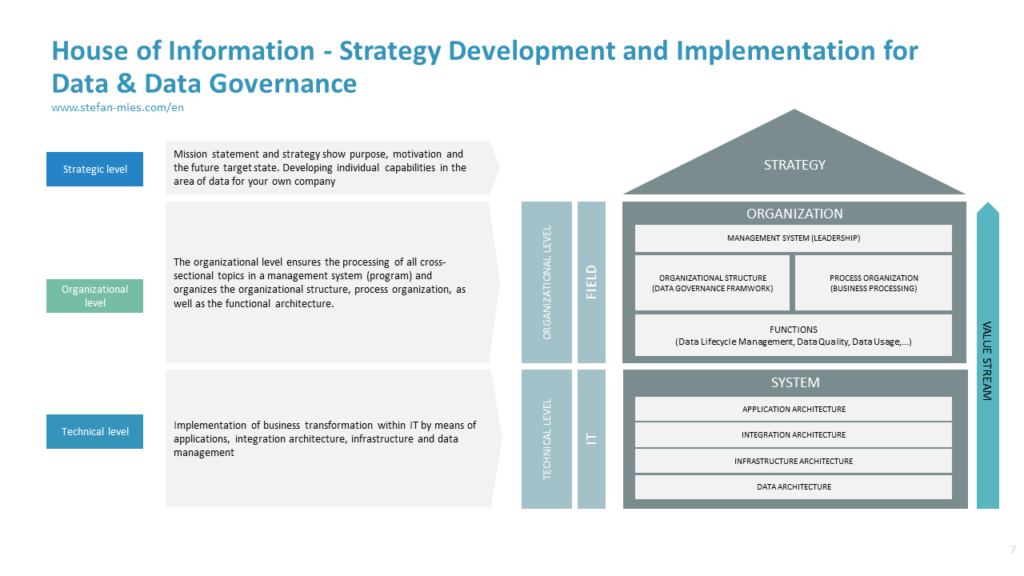
A Story of Innovation and Efficiency
As an experienced IT transformation manager and expert in data governance, I, Stefan Mies, recognized the need for a structured method for optimizing data and data governance strategies in companies in 2020. Based on this realization, I developed the “House of Information – Strategy Development and Implementation for Data & Data Governance” method to meet the complex challenges of data management.
The Method: House of Information
The “House of Information” method is based on a holistic approach that covers all important aspects of data strategy and governance. Here are the central pillars:
- Strategic Level:
- Mission Statement and Strategy: This level shows the purpose, motivation, and future target state. It is important to define a clear vision and mission that guides the overall data strategy.
- Organizational Level:
- Management System (Leadership): At this level, all cross-divisional topics are dealt with in a management system (programme).
- Organizational Structure: This is where the data governance framework is implemented, which defines the organizational and operational structure.
- Process Organization (Business Processing): The process organization ensures that the business processes run efficiently and are data-driven.
- Functions: Important functions such as data lifecycle management, data quality, and data utilization are anchored here to ensure high data quality and efficient data utilization.
- Technical Level:
- System Architecture: The technical level ensures the implementation of business transformation within IT through applications, integration architecture, infrastructure, and data management.
- Application Architecture: Development and management of the applications required for data management.
- Integration Architecture: Ensuring interoperability and seamless integration of different systems.
- Infrastructure Architecture: Building a robust infrastructure that meets the requirements of the data strategy.
- Data Architecture: Management and organization of data sources and structures.
Implementation of the Method
A practical example of the implementation of the “House of Information” method is the introduction of a central data catalog. This measure bundles all of the company’s relevant data sources in an accessible system and promotes interoperability and data quality. Another project was the development of a self-service portal for data analyses, which enabled employees without technical knowledge to access data and carry out their own analyses.
Results
Following the introduction of the method, the company has made significant progress:
- Improved Data Quality: The continuous maintenance and monitoring of data led to higher data quality and reliability.
- Optimized Business Processes: Thanks to data-driven approaches, business processes could be designed and managed more efficiently.
- Strengthened Data Literacy: Training and workshops increased data literacy and promoted a data-driven culture within the company.
Conclusion
The “House of Information” method I developed impressively demonstrates how a well-thought-out and comprehensive data strategy can help companies utilize their data effectively and ensure long-term success. This method provides a structured approach to tackling complex data management challenges and fosters a culture of collaboration and innovation.